Disposable bioreactors based on wave agitation technology
Pharmaceutical Technology Europe
Over the past decade, disposable technologies have become a reality in biotech processes. The use of disposables in research and manufacturing allows high flexibility.
Over the past decade, disposable technologies have become a reality in biotech processes. The use of disposables in research and manufacturing allows high flexibility.
The aim of cultivation in a bioreactor is to produce biomolecules using animal or plant cells, micrograms, yeast and insect cells.
Biomolecules are divided into four main classes: carbohydrates, lipids, nucleic acids and proteins.1 The latter is the most common in biotech processes: manufacturing of vaccines, diagnostics or therapeutic preparations.
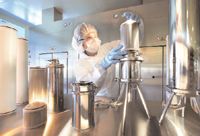
Mammalian cells constitute a demanding system for the production of heterologous proteins. Two main formats have been employed for the production of recombinant proteins in mammalians cells: cultures of adherent cells and suspension cultures. The latter is by far the most common.2 In 2004, mammalian cell-based therapeutic proteins reached a market share of 59% followed by 27% for E. coli-based products.3
Before production can start, the right cell line is screened out and the cultivation process must be optimized, for example, scaled-up, starting cultivation with a few millilitres and ending up with several cubic metres' cultivation volume.
For more than 40 years, typical bioreactors for cell cultivation have been made of glass or stainless steel (Figure 1) and have been used in research and commercial production processes. This traditional bioreactor was characterized by substantial investment cost resulting from the necessity for aseptic bioprocess technology, sterilization in place (SIP), cleaning in place (CIP) and validation, all requiring sophisticated instrumentation.
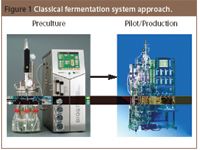
Figure 1 Classical fermentation system approach.
Disposable bioreactors with mechanical energy input represent modern alternatives to such traditional cultivation systems for some applications in lab- and pilot-scale.
The main characteristics of the single-use bioreactor are low cost, ease of operation, time saving and high process security. These parameters shorten the time-to-market.
Disposable bioreactors can be divided into two groups:
- Bag reactors with mechanical energy input where the cells are directly in contact with growth media. The most common bag reactor is based on rocking motion, where the wave-induced motion guarantees the energy input.
- Membrane cultivation systems with two chambers separated by a semipermeable membrane. The membrane enables the passage of nutrients to the cells, yet the metabolites can leave the cell chamber. High cell densities can be reached, but up-scale capability is limited to the low lab-scale level.
This article aims to outline the potential and limits of the disposable bioreactor based on wave-induced agitation for biotechnology use, while considering the working principle.
The working principle
This disposable bioreactor with wave agitation can be used for batch, fed-batch and a perfusion operation mode. It is shown that even fragile cells such as animal cells (CHO, NS0, fibroblasts and hybridoma) human cells (T-Lymphocytes, HEK and Perc.6), insect cells (Sf9, High5 with bacculo virus) and plant cells (hairy root culture, suspension cultures and embryo culture) can be grown in sealed bags made of polyethylene.6–8
Disposable bioreactors based on the rocking motion principle are mechanically-driven reactor systems, which are available in lab- (up to 25 L) and pilot-scale (up to 300 L) versions. They consist of three components:
- A rocker base unit containing a bag holder with heating capabilities.
- The biocompatible disposable chamber with integrated, single use, sensors for pH and DO.
- The measuring and control unit (Figure 2).
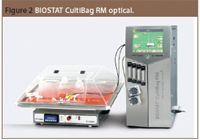
Figure 2 BIOSTAT CultiBag RM optical.
Energy input is affected by rocking the chamber back and forth, generating a fluid movement in the cell culture and medium (Figure 3). In this way, the surface of the medium is continuously renewed so bubble-free aeration can take place. Therefore, a maximum of half of the total bag volume can be filled with the cultivation media. The other half is needed for the overlay aeration. Depending on the sensitivity of the cultivated cell line, the angle and amplitude of the rocking motion, as well as velocity can be varied. Specially designed sterile plastic cultivation bags contain tubing for filling, harvesting and sampling. This allows simple handling and optimal cell growth for different cell types and cell lines.

Figure 3 Principal of rocking mixing technology.
The measuring and control unit can facilitate regulation of pH, DO, temperature, rocking rate and gas flow using the gas mixing system. An example for gas supply strategy is shown in Figure 4. The pO2 cascade control and pH control with CO2 additionally to base and acid is provided.
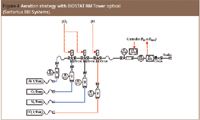
Figure 4 Aeration strategy with BIOSTAT RM Tower optical (Sartorius BBI Systems).
The used cultivation bags can be sterilized by autoclaving and then destroyed by incineration. The PE foil from which the cultivation bag is made, is environmentally compatible when incinerated. This is less critical for the environment than the cleaning of conventional bioreactors with alcohol, acids and basic solutions. An additional safety factor is the fact that no cell or protein residues are released into the wastewater cycle.
Potential and limits
The advantages of disposable bioreactors are mainly ease of use, prevention of cross-contaminations, and cost and capital investment savings. The costs compared with conventional stainless steel bioreactors are lower because the capital investment requirement is lower, and the necessity for qualification and validation processes, as well as maintenance, is reduced. A cost reduction of up to 41% compared with conventional stirred bioreactor technology is possible.4 Additionally, the disposable bioreactors enhance process safety because the contamination risk falls under 1%.10 The disadvantage of using disposable bioreactors is the limitation in scale-up (300 L) and aeration capabilities for cultivation of some microorganisms, which require high oxygen uptake rates.
Oxygenation or aeration can be achieved by three methods, individually or in combination; that is, membrane aeration, surface aeration or direct sparge aeration.
Microbial fermentations exhibit high metabolic oxygen demand together with high biomass concentration; this combination requires an energy-intensive means of maintaining adequate culture aeration. This aeration is achieved by simultaneously sparging air at high rates and vigorously agitating the culture to increase the bubble interfacial area and affect the mass transfer of oxygen.
The biomass concentrations and cellular oxygen uptake rates observed in mammalian cell cultures are low compared with microbial systems (Table 1). Even if the cellular oxygen uptake rate is low, it does not mean that oxygenation does not present a problem. The reason is the shear sensitivity of mammalian cells, which prevents the use of vigorous aeration or agitation. As a result, the volumetric oxygen mass-transfer coefficient is low and becomes a limiting factor in scale-up.
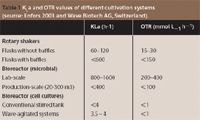
Table 1 KLa and OTR values of different cultivation systems (source: Enfors 2003 and Wave Biotech AG, Switzerland).
Bioreactors for cultivating mammalian cells are typically aerobic bioreactors and oxygen is usually a limiting nutrient because of its low solubility in culture media. When bioreactors are scaled up from laboratory to production size, their design must meet both oxygen distribution and oxygen mass transfer requirements.
One engineering parameter that could be used to compare the newly developed disposable bioreactors with established stainless steel cell-culture bioreactors could be the oxygen transfer rate (OTR). Because of its low solubility, only 0.3 mM O2, equivalent to 9 mg/L, dissolves in one litre of water at 20 °C in an air/water mixture. This amount of oxygen will be depleted in a few seconds by an active and concentrated growing culture unless oxygen is supplied continuously. In contrast, during the same period the amount of other nutrients used is negligible compared with the bulk of concentrations. Therefore, most aerobic processes are oxygen-limited. This is the reason why the concept of gas–liquid mass transfer in bioprocesses is centred on oxygen transfer even if other gasses such as carbon dioxide, hydrogen, methane and ammonia can also be involved.
The mass transfer of oxygen into liquid can be characterized by the OTR or by the volumetric oxygen transfer coefficient (KLa). The larger the KLa, the higher the aeration capacity of the system. These values have been thoroughly examined as a critical parameter for bioreactor function.

Figure 5 Disposable system approach.
Conclusion
Disposable bioreactors with wave agitation are used for commercial and R&D applications for the production of cell-derived products using animal, insect, plant and virus cultures in good manufacturing practice (GMP) and nonGMP applications. Because of their flexibility, single-use cultivation bags are especially suitable for screening new cell lines, media optimization and vaccine production. Basically, two strategies can be implemented when considering the use of disposable bioreactors:
- A partially disposable strategy; for example, preparation of inoculum in disposable cultivation bags for process-scale cultivation in conventional stirred tank reactors (Figure 5).
- A completely disposable strategy, where inoculum as well as plant bioreactors are disposables based on the rocking-motion principle (Figure 6).

Figure 6 Total disposable system approach.
In addition, the use of multiple large-scale disposable bioreactors instead of one conventional stirred tank reactor can be considered, particularly in view of their ease-of-use and process safety against contaminations of disposable bioreactors. Finally, the parameter that will document the merits of using conventional bioreactors or disposable bioreactor systems for biotechnology processes are yield of production, expenditure of time and process costs.8 The cultivation of yeast and aerobic microorganisms is, however, a challenge in disposable bioreactors. As shown in Table 2, because of the published Kla or OTR values, it is unlikely that a wave agitated system can be used for the most common microbial expression systems because of the Kla or OTR values inherent in this method.

Table 2 Oxygen uptake rate values for mammalian cells and E. coli.
Even if the market for disposable bioreactors has grown rapidly in recent years, full acceptance will only be reached when the entire production process from media preparation, inoculum preparation and downstream processes can be done using disposable equipment. Some suppliers are focusing on this issue to become a total solution provider for disposable biotech factories.
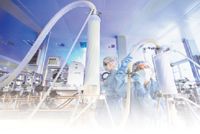
Diana Marjanovic and Gerhard Greller both at Sartorius AG, Germany.
References
1. L. Stryer, Biochemistry, Fourth Edition (W.H. Freeman and Company, New York, NY, USA, 1995).
2. F. Wurm, Nature Biotechnology, 22, 1393–1398 (2004).
3. V. Sandig et al., "Mammalian cells," in Ed. G. Gelissen, Production of recombinant proteins (Wiley-VCH; 2005) pp 233–252.
4. W. Weber et al., "Catching the Wave: The BEVS and the Biowave", Novartis Pharma Research, Switzerland.
5. D. Eibl and R. Eibl, BioWorld, 3:1–2 (Supplement BioteCHnet) (2005).
6. Pierce, Bioprocessing, J 3: 51–56 (2004).
7. Ling et al., Biotechnol. Prog., 19(1), 158–162 (2003).
8. W. Weber et al., Cytotechn, 38, 77–85 (2002).
Drug Solutions Podcast: A Closer Look at mRNA in Oncology and Vaccines
April 30th 2024In this episode fo the Drug Solutions Podcast, etherna’s vice-president of Technology and Innovation, Stefaan De Koker, discusses the merits and challenges of using mRNA as the foundation for therapeutics in oncology as well as for vaccines.
Pharmaceutical Tariffs Are Imminent: How Industry is Bracing for Impact
April 16th 2025On April 14, 2025, the Trump Administration launched a national security-driven investigation into pharmaceuticals, a move that will likely result in tariffs being placed on pharmaceutical drugs, ingredients, and other components that are imported from outside of the United States.
